Process for producing calcium trisulfoaluminate and apparatus for use in said process
a technology of calcium trisulfoaluminate and process, which is applied in the direction of rotary stirring mixer, alkali metal sulfites/sulfates, transportation and packaging, etc., can solve the problems of insufficient growth of particulates, inability to grow large enough, and inability to produce large amounts of calcium trisulfoalumina
- Summary
- Abstract
- Description
- Claims
- Application Information
AI Technical Summary
Benefits of technology
Problems solved by technology
Method used
Image
Examples
example 1
[0254]FIG. 4 shows a general flow diagram that illustrates the operating procedure of Example 1. The operation of Example 1 is explained with reference to FIG. 4. The “inline mixer” in FIG. 4 is the Pipeline Homo Mixer™ manufactured by Tokushu Kika Kogyo Co., Ltd. (specifically, the TK Pipeline Homo Mixer), which was already described in FIG. 1. However, in this case the first stirring element 15a shown in FIG. 1 has been removed and stirring part 15 is composed of only the second stirring element 15b (so that, in this case, a Pipeline Homo Mixer with only one stirring element is used). Thus a Pipeline Homo Mixer manufactured by Tokushu Kika Kogyo Co., Ltd. (specifically the TK Pipeline Homo Mixer), from which the first stirring element 15a is removed and the stirring part 15 is composed of only the second stirring element 15b, is hereinafter referred to as “single-stirrer inline mixer.”
[0255] (1) First-Stage Addition of Aqueous Aluminum Sulfate Solution to Calcium Hydroxide Suspens...
example 2
[0271] The post-reaction composition was obtained in the same way as in Example 1, except for the pH restoration time of 1 min. (30 min. in Example 1) set before carrying out the second and third stages of aluminum sulfate addition. The pH values of each mixture composition after pH restoration, before the second and third stages of addition of aqueous aluminum sulfate solution, were 12.2 and 11.8, respectively.
[0272] Furthermore, the amount of dispersion agent required to redisperse the post-reaction composition to form a 27% dispersion solution and attain the prescribed viscosity was in the ratio of 3.0 parts to the solid content in the composition.
example 3
[0273] The post-reaction composition was obtained in the same way as in Example 1, except that the aqueous aluminum sulfate solution was added in the first stage at 185 g / min (80% of the reference molar number); the mixture composition (first composition) and aqueous aluminum sulfate solution were added in the second stage at 485 g / min and 35 g / min (15% of the reference molar number), respectively; and the mixture composition (second composition) and aqueous aluminum sulfate solution were added in the third stage at 520 g / min and 11 g / min (5% of the reference molar number), respectively. In this case, the pH value of each mixture composition after the pH restoration, prior to the second and third stages of addition of aqueous aluminum sulfate solution, were 12.8 and 12.4, respectively.
[0274] In Example 3 the amount of 6% calcium hydroxide last used is 300 g / min×10 minutes=3000 g, while its solid content is 180 g. Thus the molar number ‘a’ of Ca(OH)2 is 2.43 moles.
[0275] Furthermor...
PUM
| Property | Measurement | Unit |
|---|---|---|
| average particle diameter | aaaaa | aaaaa |
| molar ratio | aaaaa | aaaaa |
| molar ratio | aaaaa | aaaaa |
Abstract
Description
Claims
Application Information
 Login to View More
Login to View More - R&D
- Intellectual Property
- Life Sciences
- Materials
- Tech Scout
- Unparalleled Data Quality
- Higher Quality Content
- 60% Fewer Hallucinations
Browse by: Latest US Patents, China's latest patents, Technical Efficacy Thesaurus, Application Domain, Technology Topic, Popular Technical Reports.
© 2025 PatSnap. All rights reserved.Legal|Privacy policy|Modern Slavery Act Transparency Statement|Sitemap|About US| Contact US: help@patsnap.com



